
As a lead developer, you understand the importance of having an effective bug tracking and reporting practice in place to ensure your team identifies and fixes bugs on time.
A well-structured and organized bug reporting template can help you ensure all necessary information is included in bug reports, as it provides developers with a clear and consistent format for reporting bugs.
To help you create a standardized way of reporting bugs, in this article, we will discuss the essential elements of bug reports and show you eight different bug reporting templates you can use.
Let’s begin by covering what a good bug report should contain.
Table of Contents
Sections a bug reporting template should have
There are several sections that we can consider essential for a good bug report, and you might want to look for these when deciding which bug-reporting template to use.
A well-made template should have all of the elements we cover below, as they are necessary to build a comprehensive and helpful bug report that developers can use to handle defects in an app effectively.
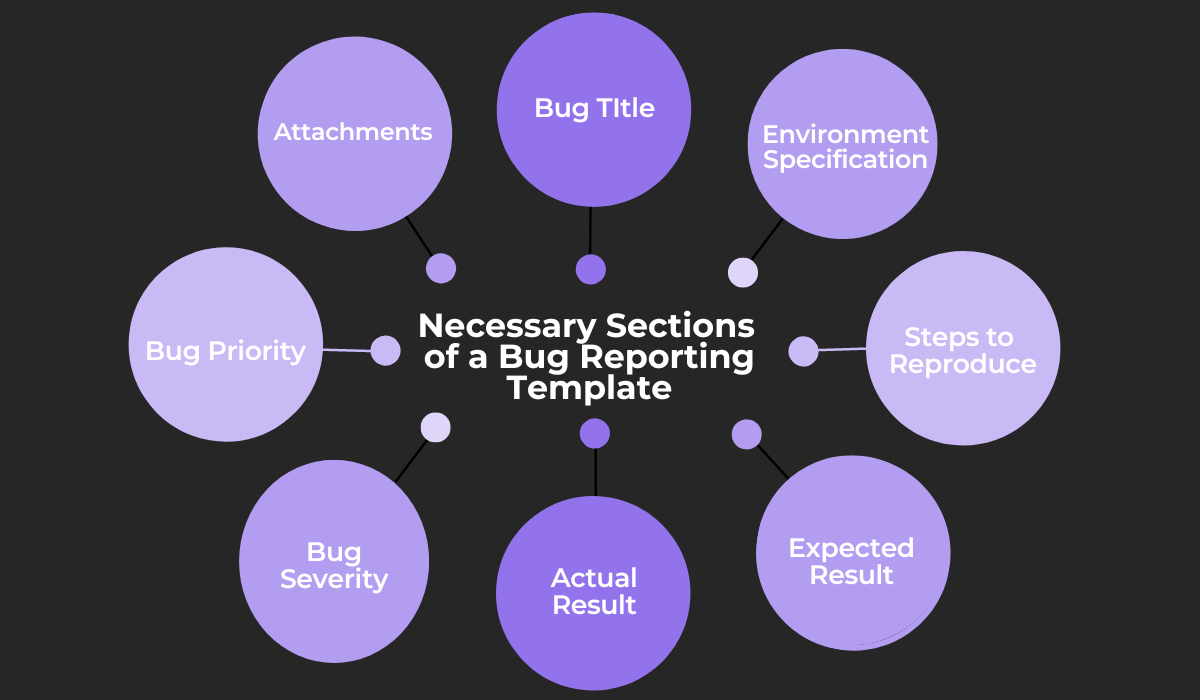
Let’s look at each of these sections separately.
The bug title should be a brief, clear and concise description of the bug that describes the problem. The title should be easily understandable and indicate the main feature affected by the bug.
A description of the environment the bug occurred in is also essential in a bug reporting template, covering, among other things:
- Device name
- App version
- Operating system
A bug reporting tool such as Shake can automatically collect this environment data when a bug or crash occurs, and include it in bug reports.
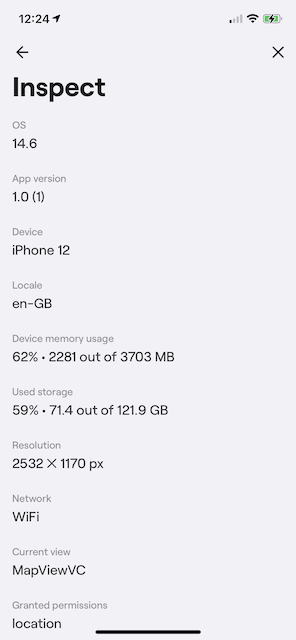
Data such as the OS, app version, device, location, network, etc., are useful as developers can use them to understand the context in which a bug occurred.
The following section should cover the steps to reproduce the bug that provides the actions developers can take to replicate the bug—enabling them to better understand the conditions and causes of the defect.
The sections on expected and actual results cover what a user should have seen or experienced had the bug not occurred and what they actually saw when the bug appeared.

Get unreal data to fix real issues in your app & web.
Bug priority and severity may be the most critical pieces of information in a bug report.
Bug severity explains the impact that the bug has on the app, while bug priority defines how urgently the bug needs to be fixed. You can read about both of them in depth here.
Finally, useful attachments are included, such as screenshots, videos, or other relevant files that can aid in understanding and reproducing the bug.
These sections are necessary to ensure developers have all relevant information about the bug—helping them prioritize and fix issues better.
Bug reporting templates you can use
When it comes to bug tracking and reporting, there are a variety of templates for various platforms available.
Each template has its own unique features and capabilities, and choosing the right tool and template will depend on your specific preferences—you can try out the ones that are most useful for your organization’s needs and goals.
In the following sections, we will discuss a few popular options you can learn more about and consider using.
Asana template
Asana is a powerful project management platform used for work organization and keeping track of various tasks.
The feature-rich and flexible nature of this platform has made it very popular as a bug-tracking tool as well.
To use Asana to help submit, track and fix bugs, you can rely on their bug tracking and reporting template that is easily customizable according to your project’s needs.
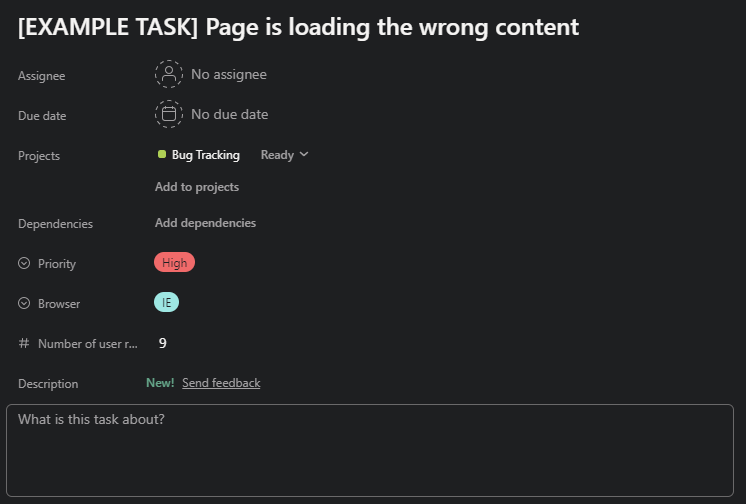
However, if you want to speed up and automate this process even further, consider using a powerful bug-reporting tool such as Shake.
Shake is a bug and crash reporting tool that helps users and testers report issues faster by automatically collecting over 70 different data metrics and attaching them to reports.
These metrics include usage data, activity history, console logs, device details, as well as screenshots, and any other attachments that users directly upload to the report.
Shake can be integrated into Asana easily by following a few simple steps, which means you can have detailed bug reports generated and forwarded to your Asana projects automatically.
ClickUp template
ClickUp is a popular productivity and task management tool that can be used to create tasks, assign them to team members, and track their progress to completion.
This platform provides an intuitive way of managing your workload and tracking projects, and offers many features, including bug tracking.
ClickUp offers its own templates that you can use and modify however you wish.
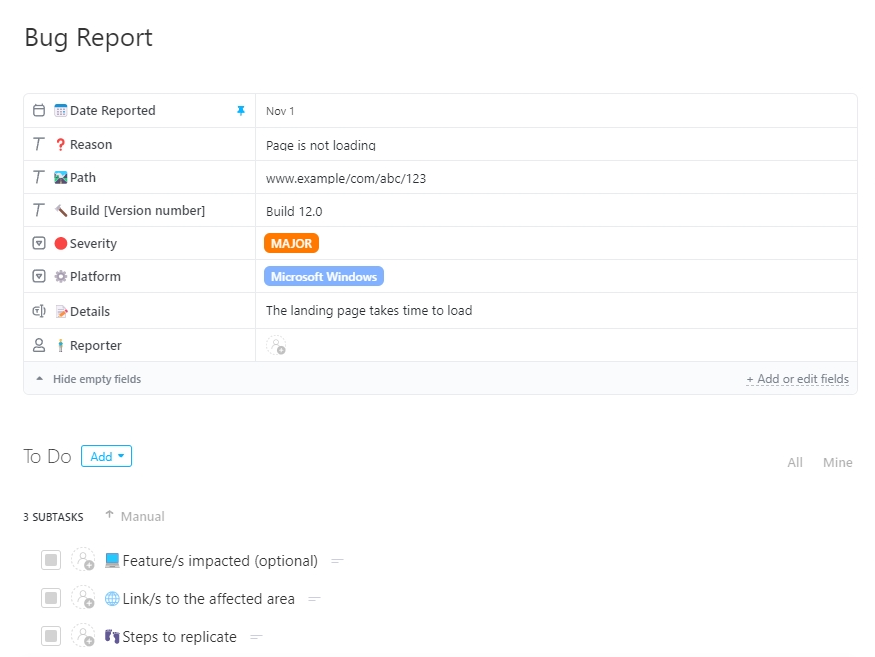
As you can see in the image, some of the essential sections of a good bug report we talked about are present, but you can always modify and add others.
Although ClickUp offers a good bug report template, you might also want to try using Shake to automate the bug reporting process.
Shake can be integrated with this platform, and the automatically generated bug and crash reports from within your app can be instantly forwarded to ClickUp as new issues or tasks.
If you are currently using ClickUp as your bug-tracking tool, try out Shake and help speed up your bug management process.

GitHub template
GitHub is a collaborative platform for software development and version control, originally created to help developers work together on software.
With GitHub, teams can manage code, track changes, collaborate on projects, and the built-in issue tracking system can help developers manage bugs and other issues effectively.
Using their customizable issue templates, contributors to your project can report the bugs they encounter and open new issues in your repository.
You can use a well-made bug reporting template to ease this process and help users write clear and uniform reports.
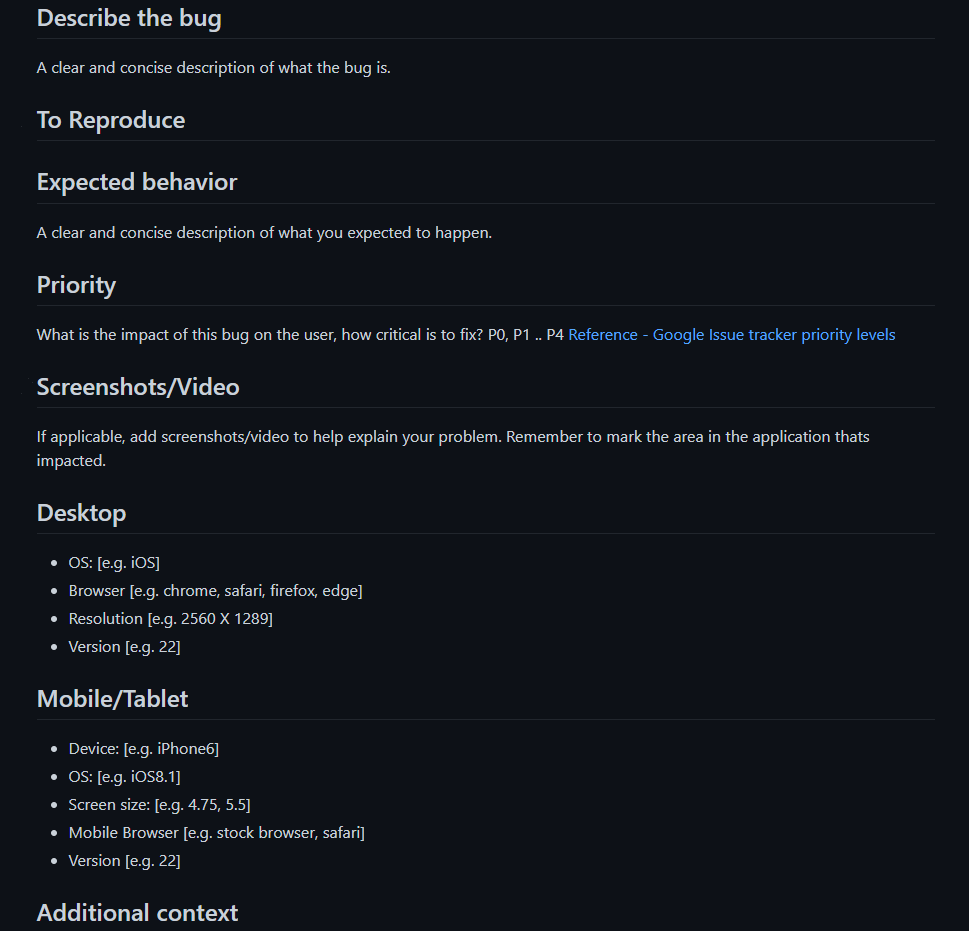
Shake can also be integrated with GitHub so that bug reports created through our tool can be forwarded to the relevant repository for tracking and management automatically.
Connecting Shake with GitHub can streamline the bug reporting process and help your team handle issues more effectively, so consider trying it out.
Jira template
Jira is a widely used tool for bug tracking and Agile project management with flexible workflows that offers a variety of features that you can use to manage bugs.
Using Jira’s bug reporting template can help your team report bugs consistently and help developers by asking reporters for useful pieces of information about the bug in question.
For example, the following template contains most of the essential elements of a good bug report.
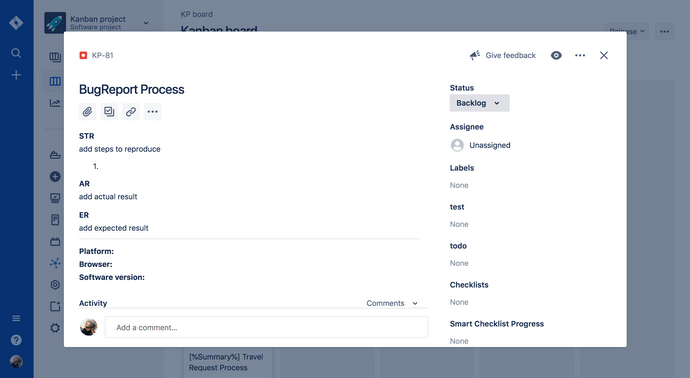
Although a template such as this one can save QA specialists and other team members valuable time, you can optimize this process even further by using a bug and crash reporting tool such as Shake.
Jira is a powerful tool, but on its own, its power lies mainly in its ability to help with tracking issues and managing tasks effectively.
Shake can add to these features by collecting relevant data when a bug or a crash occurs and sending it directly to your Jira project.
Whenever users encounter a problem, they can just shake their phone, and Shake will collect useful data automatically, generate a bug report, and the report can be forwarded and opened as a new Jira issue—ensuring everything is ready for developers to start working on a fix.
So, if you’re currently using Jira as a bug-tracking tool, consider including Shake as a great power-up that can help you make your bug management process even more efficient.
Trello template
Trello is a popular project management and organization tool that allows teams to create different boards, lists, and cards to organize and manage tasks.
This platform is used for a variety of purposes, one of which is to track and report bugs.
Trello’s bug reports typically consist of different cards that represent individual bugs—these cards can be organized into boards to track the progress of the bug through different stages of its life cycle.
Here’s a template that you can use to ensure testers fill out the required information that the developers need to work on the issue.
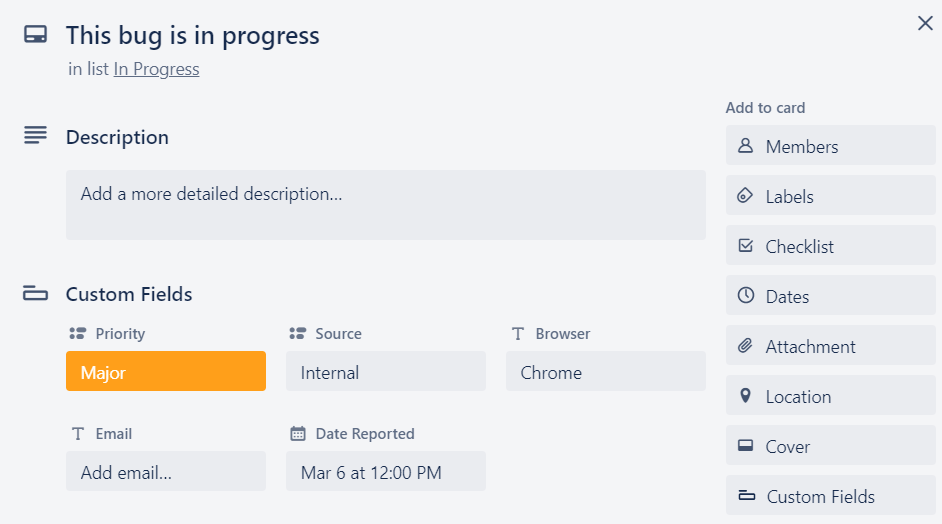
This template contains fields for some essential information about the bug, such as its title, description, priority, etc.
As with the previously mentioned tools, Shake can be integrated with Trello, and bug reports can be automatically forwarded for easy tracking and management—allowing developers to receive bug reports directly in Trello as cards.
Try out Shake for free if your organization already uses Trello to manage bugs.
Email template
Compared to the bug tracking and reporting tools we have covered so far, using email to report bugs might seem outdated, but a well-structured email that follows a good bug reporting template can still be a useful way to manage defects.
Emails can provide a consistent bug-reporting format for teams that won’t make use of a complex bug-tracking tool with an abundance of features.
For example, look at this template:
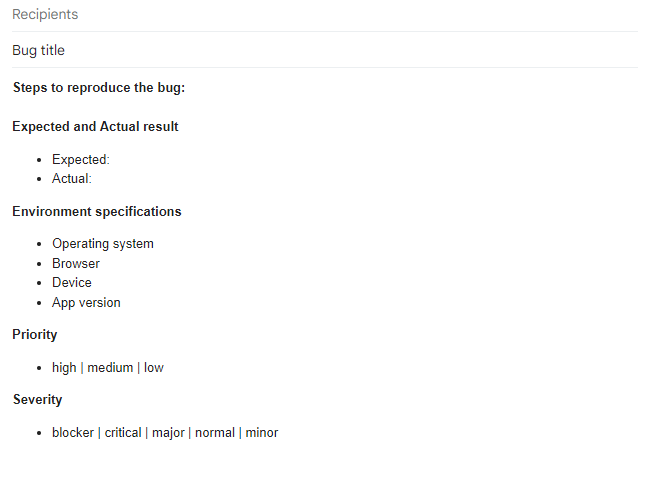
This simple email template covers all of the necessary elements that need to be included in a comprehensive bug report, and it can be easily recreated in Gmail, Outlook, or any other email client you use.
Just make sure the template contains every piece of information that your team needs to fix the bug—you don’t want incomplete bug reports and having to contact testers that sent you the email for additional clarification.
Reporting bugs via email is a good option for small teams or projects that don’t require the level of complexity of other tools—if this applies to you and your organization, try it out.
Excel template
While there are other more feature-rich options available, such as Asana, Jira, and Trello, Excel or Google Sheets can be good options for organizations that do not need additional features and simply want a basic tool for bug reporting.
Creating a bug reporting template in Excel or Google Sheets is very simple, and you can even download a premade template to help you get started.
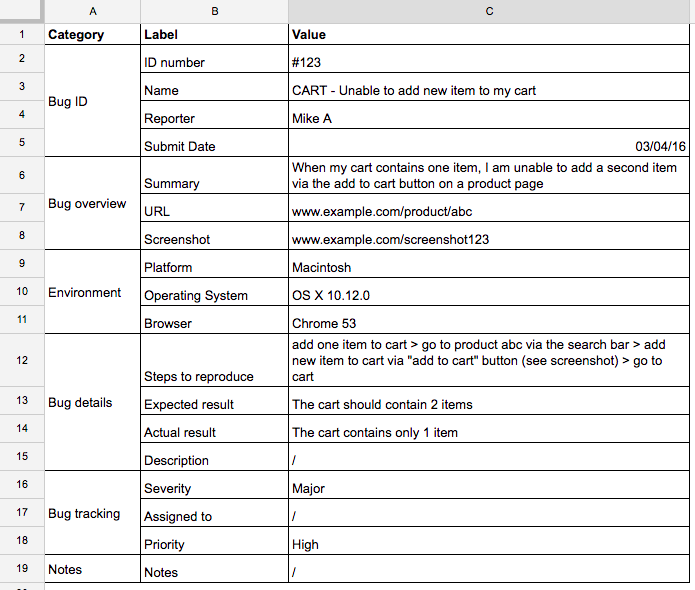
This template contains all the essential elements for a good bug report in a plain but structured way—providing your organization with a straightforward, uniform way of reporting bugs.
If you work in a smaller organization that needs a minimal and simple method for reporting bugs, tracking them with a spreadsheet can get the job done without much hassle.
Word template
As with the last two options, reporting bugs in Microsoft Word is not the most efficient way, but it can be done.
Having the QA team and other team members report bugs manually in Word or Google Docs, Google’s online document editor, can be a straightforward way to report issues for organizations that don’t need the extra features provided by bug tracking systems.
An example of a bug-reporting template made in Word is shown below.
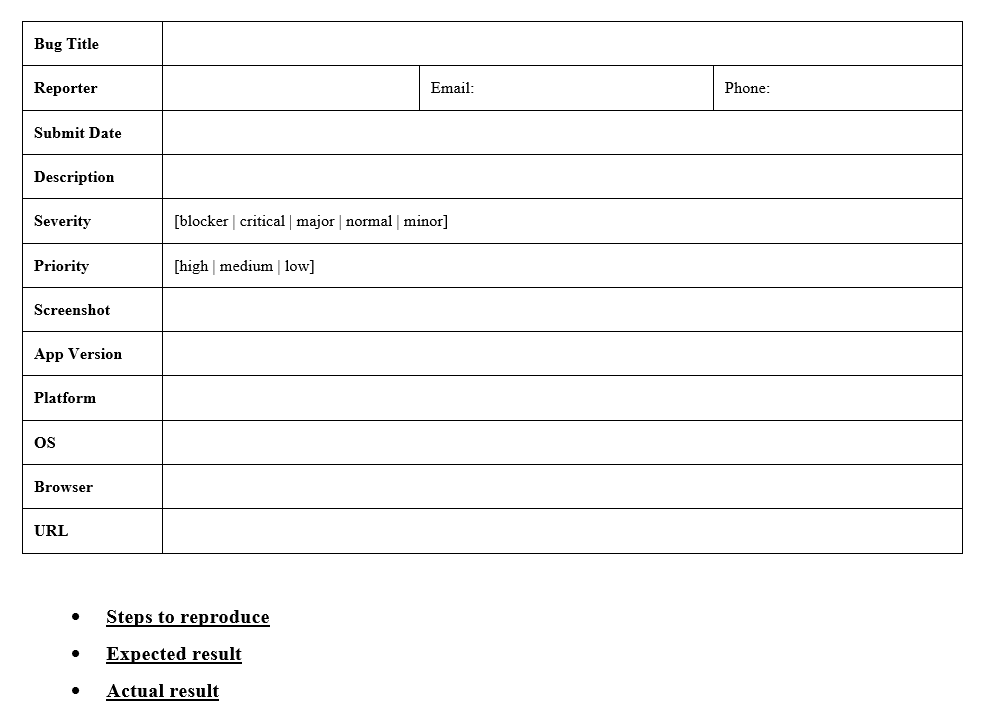
This template contains all the necessary elements of a quality bug report, such as severity, priority, environment specifications, etc., and can be modified according to your wishes.
Reporting bugs in Word might be more time-consuming than using some of the other tools we included in this list, but it might be useful for specific cases.

Capture, Annotate & Share in Seconds with our Free Chrome Extension!
Each of the bug reporting templates we covered has its own unique benefits and can be the best fit for different organizations.
It’s important to evaluate the needs of your team and the type of projects you work on to determine which template will work best for you.
Conclusion
Choosing the right platform and template for your projects can seem like a daunting task, especially with so many different options available.
Still, it’s one of the most important steps you can take to ensure bugs are properly and efficiently taken care of throughout your project’s development lifecycle.
A helpful bug-reporting template, coupled with a powerful tool such as Shake, can help make bug management an efficient and smooth process.
The templates provided in this article are just a few examples of the many options available, and you might want to further explore the tools and templates that may fit you best.





